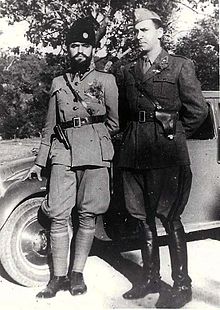Dinara Division
| Dinara Division | |
|---|---|
Anti-Communist Volunteer Militia (1942–43) | |
| Engagements | World War II in Yugoslavia |
| Commanders | |
| Notable commanders | Momčilo Đujić |
The Dinara Division (
In late 1944 the division began withdrawing towards Slovenia. Afterwards, it joined
Background
On 6 April 1941,
Formation and objectives

The division was formed in early January 1942 after Đujić was contacted by Mihailović via a courier. Ilija Trifunović-Birčanin played a central role in organizing the units of Chetnik leaders in western Bosnia, Lika, and northern Dalmatia into the Dinara Division and dispatched former Royal Yugoslav Army officers to help. Đujić was designated the commander of the division and its goal was for the "establishment of a Serb national state" in which "an exclusively Orthodox population is to live".[10] According to Đujić: "We were under Draža's command, but we received news and supplies for our struggle from [Dimitrije] Ljotić and [Milan] Nedić. [...] Nedić's couriers reached me in Dinara and mine reached him in Belgrade. He sent me military uniforms for the guardists of the Dinara Chetnik Division; he sent me ten million dinars to obtain for the fighters whatever was needed and whatever could be obtained."[11]
In March 1942 the division prepared a programmatic statement that concerned the "specific conditions of
Decline and retreat to the Adriatic Littoral
During early February 1943, as the Partisans began to prevail over the Chetniks as part of
On 21 December 1944, after Đujić requested a written guarantee from Ante Pavelić to afford him and his forces refuge in
Aftermath
In May 1945, Đujić surrendered the Dinara division to
Notes
- ^ Cohen 1996, p. 28.
- ^ Tomasevich 2001, p. 272.
- ^ Tomasevich 2001, pp. 397–409.
- ^ Hoare 2007, pp. 20–24.
- ^ Ramet 2006, p. 120.
- ^ Ramet 2006, p. 4.
- ^ Tomasevich 1975, p. 218.
- ^ Mihael Sobolevski; (2004) Chetnik Division in the Krivi Put Region on 28th and 29th December 1944 p. 95-96, [1]
- ^ Mihael Sobolevski; (2004) Chetnik Division in the Krivi Put Region on 28th and 29th December 1944 p. 96, [2]
- ^ Hoare 2006, p. 291.
- ^ Hoare 2006, p. 293.
- ^ Tomasevich 1975, p. 171.
- ISBN 8634300102
- ^ Mihael Sobolevski; (2004) Chetnik Division in the Krivi Put Region on 28th and 29th December 1944 p. 96, 99 [3]
- ISBN 8634300102
- ^ Milazzo 1975, p. 121.
- ^ Milazzo 1975, p. 151.
- ^ a b Cohen 1996, pp. 45–47.
- ^ Tomasevich 1975, p. 442.
- ^ a b Binder 1999.
- ^ Hockenos 2003, p. 119.
References
- Binder, David (13 September 1999). "Momcilo Djujic, Serbian Priest and Warrior, Dies at 92". The New York Times.
- Cohen, Philip J. (1996). Serbia's Secret War: Propaganda and the Deceit of History. ISBN 978-0-89096-760-7.
- ISBN 978-0-19-726380-8.
- Hoare, Marko Attila (2007). The History of Bosnia: From the Middle Ages to the Present Day. ISBN 978-0-86356-953-1.
- Hockenos, Paul (2003). Homeland Calling: Exile Patriotism and the Balkan Wars. ISBN 978-0-8014-4158-5.
- Milazzo, Matteo J. (1975). The Chetnik Movement & the Yugoslav Resistance. ISBN 0-8018-1589-4.
- Ramet, Sabrina P. (2006). The Three Yugoslavias: State-Building and Legitimation, 1918–2005. ISBN 978-0-253-34656-8.
- ISBN 978-0-8047-0857-9.
- Tomasevich, Jozo (2001). War and Revolution in Yugoslavia, 1941–1945: Occupation and Collaboration. ISBN 978-0-8047-3615-2.
